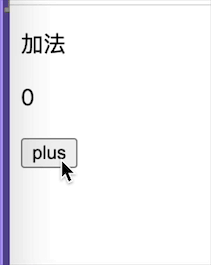React16是否能异步渲染,在于内部一个变量。在开始之前,我们需要准备一个例子。
<!DOCTYPE html>
<html lang="en">
<head>
<Meta charset="utf-8">
<title>by 司徒正美</title>
<Meta name="viewport" content="width=device-width">
<!-- <script type='text/javascript' src="./src/React2.js"></script>-->
<script type='text/javascript' src="./test/react.js"></script>
<script type='text/javascript' src="./test/react-dom.js"></script>
<script src="test/babel.js"></script>
</head>
<body>
<div id="test"></div>
<div id="content"></div>
</body>
<script type="text/babel">
var container = document.getElementById("test");
class Root extends React.Component{
constructor(props){
super(props)
this.props = props
}
render(){
console.log("Root render..",Date.Now())
return <div><A /></div>
}
}
class A extends React.Component{
constructor(props){
super(props)
this.props = props
}
render(){
console.log("A render..",Date.Now())
return <div>{1111}</div>
}
}
ReactDOM.render(<Root />,container,function(){
console.log("callback",Date.Now())
})
console.log("end",Date.Now())
</script>
</html>
当中的react.js与react-dom.js是React16.4beta,大家可以在bootcdn上下载。
前文已经提过,ReactDOM.render/hydrate/unstable_renderSubtreeIntoContainer/unmountComponentAtNode都是legacyRenderSubtreeIntoContainer方法的加壳方法。
legacyRenderSubtreeIntoContainer里面调用legacyCreateRootFromDOMContainer创建一个ReactRoot对象,然后再调用其render或legacy_renderSubtreeIntoContainer方法
//by 司徒正美 function legacyCreateRootFromDOMContainer(container,forceHydrate) { var shouldHydrate = forceHydrate || shouldHydrateDuetoLegacyHeuristic(container); // First clear any existing content. if (!shouldHydrate) { var warned = false; var rootSibling = void 0; while (rootSibling = container.lastChild) { { if (!warned && rootSibling.nodeType === ELEMENT_NODE && rootSibling.hasAttribute(ROOT_ATTRIBUTE_NAME)) { warned = true; warning_1(false,'render(): Target node has markup rendered by React,but there ' + 'are unrelated nodes as well. This is most commonly caused by ' + 'white-space inserted around server-rendered markup.'); } } container.removeChild(rootSibling); } } { if (shouldHydrate && !forceHydrate && !warnedAboutHydrateAPI) { warnedAboutHydrateAPI = true; lowPriorityWarning$1(false,'render(): Calling ReactDOM.render() to hydrate server-rendered markup ' + 'will stop working in React v17. Replace the ReactDOM.render() call ' + 'with ReactDOM.hydrate() if you want React to attach to the server HTML.'); } } // Legacy roots are not async by default. var isAsync = false; console.log("new ReactRoot",isAsync,shouldHydrate) return new ReactRoot(container,shouldHydrate); }
留意里面的isAsync,是写死的,强制使用同步,我们可以改一改,就能使用异步
var isAsync = true;
本节的内容就准备读如何 异步渲染。
ReactRoot之前已经说过,再贴一下源码。

从Domrenderer.updateContainer到达updateContainerAtExpirationTime到达scheduleWork到达scheduleWork到达scheduleWorkImpl到达requestWork,我们一路加点注释
下面是scheduleWorkImpl的代码:
requestWork里面才进行同步异步逻辑分家
scheduleCallbackWithExpiration是干了什么呢?它会判定是否工作与不干作,工作就是重新计算过期时间,然后执行scheduleDeferredCallback方法。scheduleDeferredCallback有两个参数,第一个是回调函数,第二个是对象,里面的timeout决定它在执行scheduleDeferredCallback最迟多少ms才执行。
scheduleDeferredCallback是何方神圣呢?它是大名鼎鼎的requestIdleCallback
requestIdleCallback的语法如下:
performAsyncWork与performSyncWork也是一对兄弟。
//by 司徒正美
function performAsyncWork(dl) {
performWork(Nowork,true,dl);
}
function performSyncWork() {
performWork(Sync,false,null);
}
performWork的源码
function performWork(minexpirationTime,dl) { deadline = dl; // Keep working on roots until there's no more work,or until the we reach // the deadline. findHighestPriorityRoot(); if (enableuserTimingAPI && deadline !== null) { var didExpire = nextFlushedExpirationTime < recalculateCurrentTime(); stopRequestCallbackTimer(didExpire); } if (isAsync) { while (nextFlushedRoot !== null && nextFlushedExpirationTime !== Nowork && (minexpirationTime === Nowork || minexpirationTime >= nextFlushedExpirationTime) && (!deadlineDidExpire || recalculateCurrentTime() >= nextFlushedExpirationTime)) { performWorkOnRoot(nextFlushedRoot,nextFlushedExpirationTime,!deadlineDidExpire); findHighestPriorityRoot(); } } else { while (nextFlushedRoot !== null && nextFlushedExpirationTime !== Nowork && (minexpirationTime === Nowork || minexpirationTime >= nextFlushedExpirationTime)) { performWorkOnRoot(nextFlushedRoot,false); findHighestPriorityRoot(); } } // We're done flushing work. Either we ran out of time in this callback,// or there's no more work left with sufficient priority. // If we're inside a callback,set this to false since we just completed it. if (deadline !== null) { callbackExpirationTime = Nowork; callbackID = -1; } // If there's work left over,schedule a new callback. if (nextFlushedExpirationTime !== Nowork) { scheduleCallbackWithExpiration(nextFlushedExpirationTime); } // Clean-up. deadline = null; deadlineDidExpire = false; finishRendering(); }
下面是同步与异步的执行情况
但异步模式为什么会调用两次render呢?估计这还在测试阶段,许多BUG。我们追踪到finishClassComponent方法,看到它的render方法:
我们再改一下Root组件的代码,添加一个componentDidMount.
class Root extends React.Component{
constructor(props){
super(props)
this.props = props
this.state = {
x: 1
}
}
render(){
console.log("Root render..",Date.Now())
return <h1><A x={this.state.x} /></h1>
}
componentDidMount(){
console.log("Root componentDidMount")
this.setState({
x: 2
})
}
}
class A extends React.Component{
constructor(props){
super(props)
this.props = props
this.state = {
text: props.x
}
}
componentwillReceiveProps(p){
this.setState({
text: p.x
})
}
render(){
console.log("A render..",Date.Now())
return <h2>{this.state.text}</h2>
}
}
我们再看一下fiber树。fiber有许多种类型,但主要是四种, ClassFiber,FunctionFiber,HostComponentFiber,HostTextFiber,分别对应原来的类组件,无状态组件,元素虚拟节点,文本虚拟节点。Fiber表面上比React15的虚拟DOM多了一些属性,如parent,child,sibling。换言之,fiber可以像真实DOM一样上下右遍历(没有左)。
React16的源码里面有两个方法beginWork与finishWork重要方法。beginWork,就是从一个Fiber开始,初始化它的state(如果fiber.type为函数,则new 实例或一个类似类似的东西,如果type为标签名,则创建元素节点或文本节点),并遍历它的第一重孩子,让孩子们加上parent,sibling(注意这时孩子没有stateNode)。最后返回第一个孩子,作为刚才fiber的child。 然后对这个child再执行beginWork操作。
beginWork的过程中,确到组件,需要用到context,context是来自contextStack。这是一个全局对象。在顶层,默认会push一个空对象。然后到达某个组件时,peek一下(不使用pop方法)。 如果这个组件有getChildContext方法呢,这时就会产生一个新context,push进去。
有些fiber是没有孩子的,比如说文本节点,或一些元素节点,这样它开始 finishWork操作,找它的sibling,对sibling进行beginWork操作,没有sibling就往上找,这时就会再次访问到某个组件,如果这个组件有getChildContext,于是就pop一下。
finishWork还有一个重要任务,就是收集DOM操作指令,一开始所有fiber的effects都PLACEMENT,叫做置换,其实相当于append。每次往上找时,父fiber就把它所有孩子的effect收集一下,最后到顶层Root组件时, contextStack为空,而effects则装得满满的,然后交给commintAllWork执行这些指令。
fiber架构是很好地解决context的往下传送问题。




